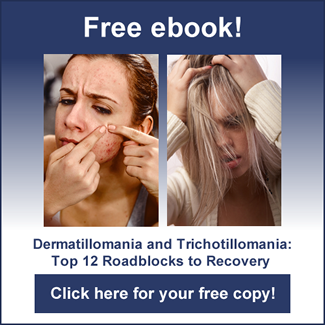Dermatillomania and Trichotillomania
Dermatillomania and Trichotillomania – Symptoms and Treatment
The primary characteristic of Dermatillomania (also known as Skin Picking Disorder or Excoriation) is the repetitive picking at one’s own skin to the extent of causing damage. The defining characteristic of Trichotillomania is the recurrent, compulsive pulling out of one’s own hair, often resulting in observable hair loss.
The most common hair pulling sites are the scalp, eyebrows, and eyelashes, while the face is the most common location for skin picking. However, Dermatillomania and Trichotillomania may involve any part of the body. Individuals with either condition may pull or pick in their pubic area, their perirectal region, and/or their arms, legs, feet, back or chest. Those with Dermatillomania may pick at normal skin variations such as freckles and moles, at actual pre-existing scabs, sores or acne blemishes, or at imagined skin defects that nobody else can observe. Individuals with either condition may use their fingernails, tweezers, pins or other mechanical devices.
Often, but not always, episodes of Dermatillomania and/or Trichotillomania are preceded by a high level of tension and a strong “urge”. Likewise, hair pulling and skin picking are usually, but not always, followed by a sensation of relief, pleasure, or gratification. Hair pulling and skin picking are usually done alone, often while watching TV, reading, driving, talking on the phone, or while grooming in the bathroom.
An episode of Dermatillomania or Trichotillomania may be triggered by a negative mood state or occur in response to stress, but may also occur while an individual is calm and relaxed. Sometimes hair pulling and skin picking are done as a conscious behavior, but may also be done as an unconscious habit. Recent reports indicate that approximately 10% of those with Trichotillomania also eat their hair after they pull it (Trichophagia). This can result in hairballs called bezoars, which can lead to severe gastrointestinal blockage. Some people with Dermatillomania also eat their skin and scabs, though there is less research on this issue. Dermatillomania often causes bleeding, and may also result in bruises, infections, and/or permanent disfigurement of the skin. Trichotillomania may result in permanent hair loss.
Individuals with Dermatillomania and Trichotillomania often attempt to camouflage the skin damage and hair loss that accompany these conditions. Common camouflaging techniques include the use of hats, scarves, make-up, long pants, and long-sleeve shirts. Some with Trichotillomania may use false eyelashes, or in some cases have false eyebrows permanently tattooed. In extreme cases, individuals with either condition may avoid social situations in an effort to prevent others from seeing their skin damage or hair loss.
As demonstrated above, Dermatillomania and Trichotillomania have symptoms that are quite similar, and both conditions are sometimes described as “body-focused repetitive behaviors” (BFRBs). Likewise, both conditions have obsessive-compulsive features and are considered Obsessive Compulsive Spectrum Disorders. Both Trichotillomania and Dermatillomania are commonly experienced by those with Obsessive-Compulsive Disorder (OCD) and Body Dysmorphic Disorder (BDD). In fact, one research study found that 23% of individuals with OCD, and 27% of those with BDD, also had Skin Picking Disorder.
or call us at 310 824-5200
Treatment of Dermatillomania and Trichotillomania
The most effective treatment for Dermatillomania and Trichotillomania is a combination of various types of Cognitive-Behavioral Therapy (CBT). Perhaps the most important of these is called Habit Reversal Training (HRT). HRT is based on the principle that hair pulling and skin picking are learned, conditioned responses to specific situations and events, and that an individual with these conditions is frequently unaware of these triggers. HRT challenges hair pulling and skin picking in a two-fold process. First, the individual learns how to become more consciously aware of situations and events that trigger hair-pulling and/or skin picking episodes. Second, the individual learns to utilize alternative behaviors in response to these situations and events.
Other Cognitive-Behavior Therapy techniques can be used as adjuncts to HRT in the treatment of Skin Picking Disorder and Trichotillomania. Among these are Stimulus Control techniques and Cognitive Restructuring. Stimulus Control techniques involve utilizing specific physical items as “habit blockers” to restrict the ability to pull hair and pick skin, while Cognitive Restructuring helps an with these conditions learn to think differently in response to the urge to pull their hair or pick their skin.
 One of the most effective CBT developments for the treatment of Skin Picking Disorder and Trichotillomania is Mindfulness Based Cognitive Behavioral Therapy. The primary goal of Mindfulness-Based CBT is to learn to non-judgmentally accept uncomfortable psychological experiences. From a mindfulness perspective, much of our psychological distress is the result of trying to control and eliminate the discomfort of unwanted thoughts, feelings, sensations, and urges. In other words, our discomfort is not the problem – our attempt to control and eliminate our discomfort is the problem. For those with Trichotillomania or Skin Picking Disorder, the ultimate goal of mindfulness is to develop the ability to more willingly experience their uncomfortable thoughts, feelings, sensations, and urges, without pulling their hair or picking their skin. To learn more about Mindfulness Based CBT for the treatment of Trichotillomania and Skin Picking Disorder, click here.
One of the most effective CBT developments for the treatment of Skin Picking Disorder and Trichotillomania is Mindfulness Based Cognitive Behavioral Therapy. The primary goal of Mindfulness-Based CBT is to learn to non-judgmentally accept uncomfortable psychological experiences. From a mindfulness perspective, much of our psychological distress is the result of trying to control and eliminate the discomfort of unwanted thoughts, feelings, sensations, and urges. In other words, our discomfort is not the problem – our attempt to control and eliminate our discomfort is the problem. For those with Trichotillomania or Skin Picking Disorder, the ultimate goal of mindfulness is to develop the ability to more willingly experience their uncomfortable thoughts, feelings, sensations, and urges, without pulling their hair or picking their skin. To learn more about Mindfulness Based CBT for the treatment of Trichotillomania and Skin Picking Disorder, click here.
Individual Therapy for Dermatillomania and Trichotillomania
The OCD Center of Los Angeles offers individual therapy for the treatment of adults, children, and adolescents with Dermatillomania and Trichotillomania. Using the Cognitive Behavioral Therapy techniques outlined above, clients with these conditions learn to respond differently to thoughts about their hair and skin, and to resist the urge to pull or pick.
We have 14 therapists on staff, and offer services six days a week, including evenings and Saturdays. If you would like to discuss treatment options at the OCD Center of Los Angeles, please call one of our client coordinators at (310) 824-5200 (ext. 4), or click here to email us.
Group Therapy for Dermatillomania and Trichotillomania
In addition to individual therapy, the OCD Center of Los Angeles also offers five weekly, low-fee, therapy/support groups, including a group exclusively for adults with Dermatillomania and Trichotillomania. This group is led by one of our licensed staff therapists, Chanel Taghdis, MFT, and uses the same treatment protocol as our individual Cognitive-Behavioral Therapy program. Our weekly Dermatillomania / Trichotillomania group is held on Tuesday evenings at our Brentwood location in Los Angeles. The group is limited to eight (8) members, and requires an assessment prior to participation. For more information on this group, click here.
Telephone and Online Therapy for Dermatillomania and Trichotillomania
The OCD Center of Los Angeles also offers webcam based online therapy and telephone therapy to clients around the world suffering with Skin Picking Disorder and/or Trichotillomania. Telephone and online therapy are cost-effective options for clients who have physical and/or psychological limitations that restrict their ability to come to our office, and for those in remote areas who cannot find specialized treatment close to their home. Telephone and online therapy have repeatedly been found to be safe and effective in numerous research studies, and have been legal in California since 1997. If you would like to learn more about our telephone and online therapy program for Dermatillomania and Trichotillomania, please click here.
Intensive Treatment for Dermatillomania and Trichotillomania
We also offer intensive Dermatillomania and Trichotillomania treatment for adults, adolescents, and children. This program is designed to meet the needs of those for whom standard outpatient treatment is either unavailable or insufficient. Our intensive outpatient program is ideal for clients from other states or countries who cannot find effective treatment near to their homes, and for those whose symptoms require a more rigorous treatment protocol. To learn more about our intensive outpatient treatment program, click here.
About the OCD Center of Los Angeles
The OCD Center of Los Angeles is a private outpatient treatment center specializing in Cognitive Behavioral Therapy (CBT) for the treatment of OCD and related conditions, including Dermatillomania and Trichotillomania. We have 14 therapists on staff, all of whom are either licensed or registered, and all of whom specialize in CBT. We treat adults, adolescents, and children, and offer services six days a week, including evenings and Saturdays.
We have 3 Southern California offices located in:
- Brentwood
- Pasadena
- Newport Beach
If you are experiencing any of the above symptoms of Dermatillomania or Trichotillomania, and would like to discuss treatment or a consultation, please call one of our client coordinators at (310) 824-5200 (ext. 4), or click here to email us.

